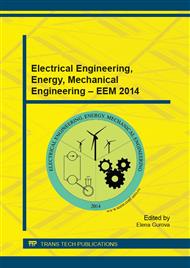p.768
p.774
p.780
p.785
p.790
p.796
p.803
p.808
p.815
Triple Power Effect in Power Supply Systems of Buildings due to Automated Energy-Efficient Windows
Abstract:
New energy saving windows with heat-reflecting shields are well known, but their practical use requires that they should be integrated into the automated system of controlling heat supply in buildings, and the efficiency of their use, as well as the existing energy-saving measures must be determined. The study was based on the results of field tests of windows with heat-reflective shields in a certified climate chamber. A method for determining the required minimum indoor air temperature in setback heating mode using heat-reflective shields in windows has been worked out. An automated system of controlling heat supply in buildings using heat-reflecting screens has been developed.
Info:
Periodical:
Pages:
790-795
Citation:
Online since:
December 2014
Authors:
Price:
Сopyright:
© 2015 Trans Tech Publications Ltd. All Rights Reserved
Share:
Citation:


